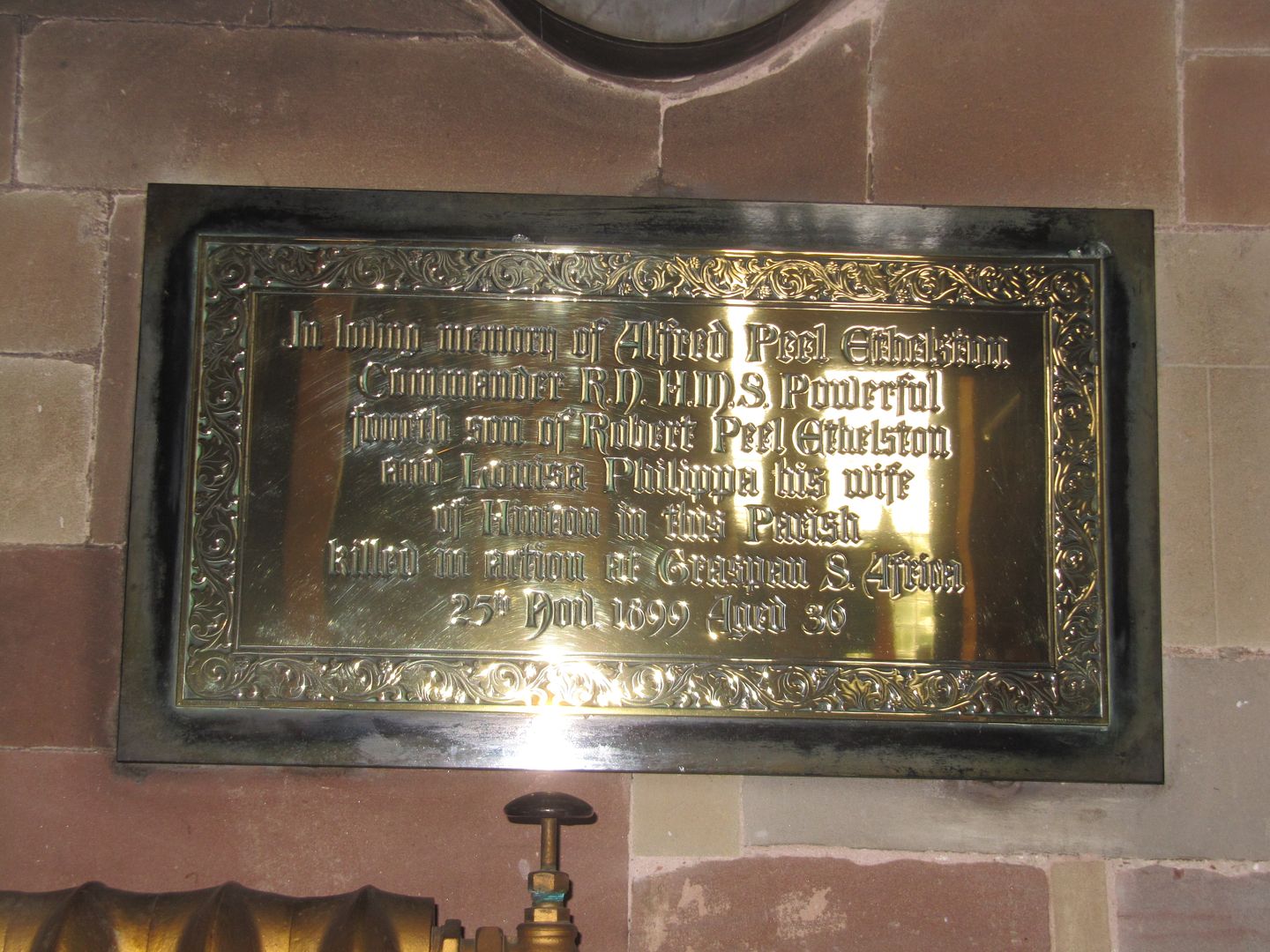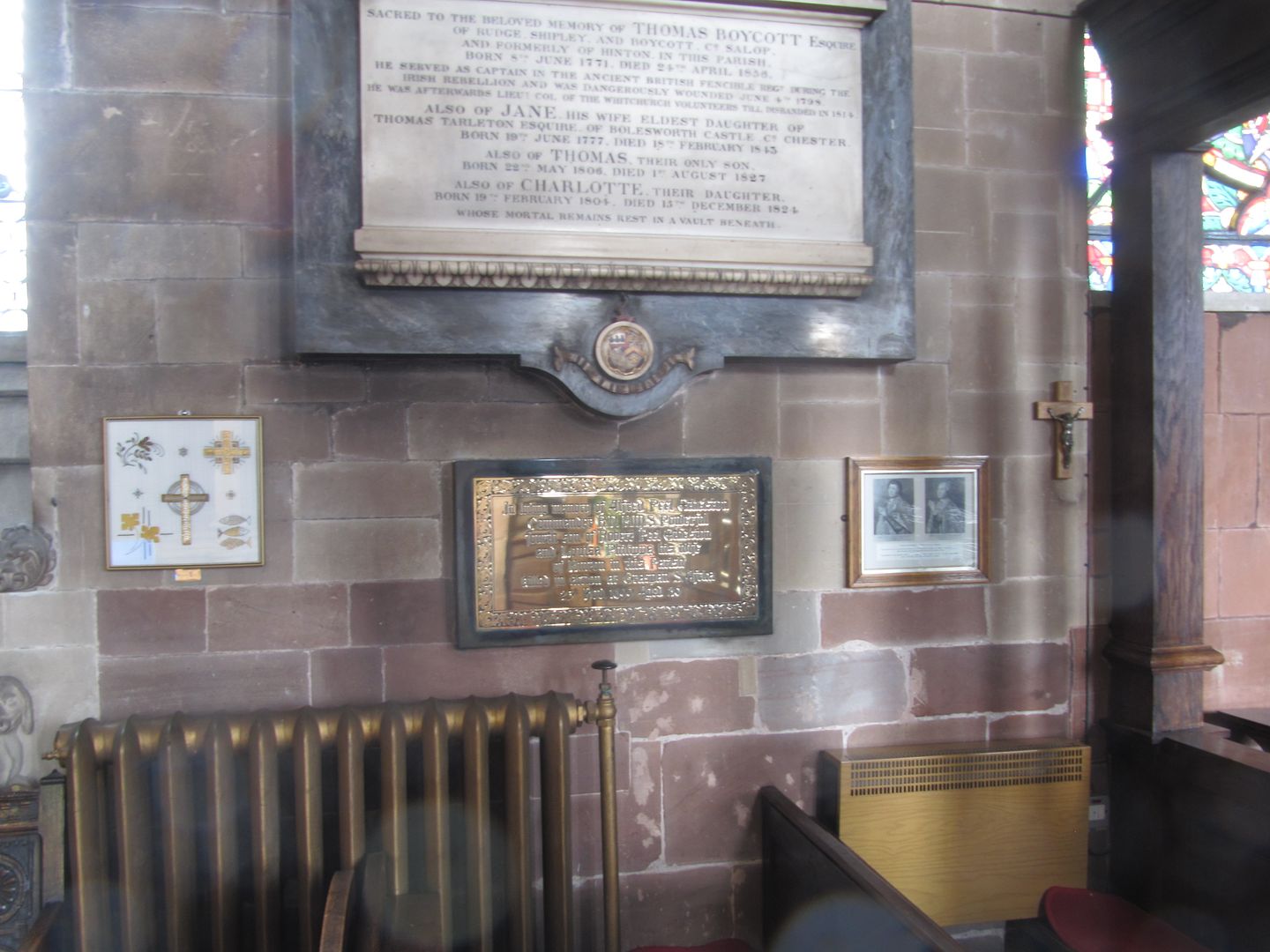At St. Alkmund's Church, Whitchurch, Shropshire.
In loving memory of Alfred Peel Ethelston,
Commander R.N. H.M.S. Powerful
fourth son of Robert Peel Ethelston
and Louisa Philippa his wife
of Hinton in this Parish
killed in action at Graspan S. Africa
25th Nov 1899 Aged 56.
AT THE FRONT.
Men Who are Conducting the War,
Commander Alfred Peel Ethelston, who has landed with the Powerful's naval brigade, and is supposed to have gone up the Orange River, served at Suakim in the Egyptian campaign of 1884-5, receiving the medal and bronze star. He became commander in 1897.
(Evening Express, Saturday, 18 November 1899)
_____________________________________________________
COMMANDER ETHELSTON KILLED.
PAINFUL SENSATION AT WHITCHURCH.
The Naval Brigade, who receive special mention in Lord Methuen's despatch for their gallantry, suffered very severely in the engagement at Gras Pan on Saturday. They lost Commander Ethelston, Powerful; Major Plumbe, R.M.L.I., Doris; and Captain Senior, R.M.A., Monarch, and their casualties numbered altogether 105.
Commander Alfred Peel Ethelston, of the cruiser Powerful, who is among the killed at the battle of Gras Pan, joined the Navy in 1875, and two years later became a midshipman. In 1882 he attained the rank of sub-lieutenant, was promoted to a lieutenancy in 1885, and was made commander at the beginning of 1897. As sub-lieutenant of the Helicon he took part in the naval and military operations in the Eastern Soudan in 1884-5, for which he received the Egyptian medal and the Khedive's bronze star. Commander Ethelston was appointed to the Powerful two years ago.
The intelligence that Commander Ethelston had been killed has created a painful sensation at Whitchurch. The deceased officer was born at Hinton, and his death is deeply deplored, not only by the townspeople, but by a large circle of relatives. For ten years his brother, Captain Ethelston, commanded the Royal Welsh Fusiliers. His father is a county magistrate and chairman of the Whitchurch Bench of Magistrates and Board of Guardians. Flags are flying half-mast at the Parish Church and Drill Hall.
Commander Ethelston was equally well-known at Portsmouth. Some years ago he was captain of the United Service Football Club, the leading naval and military combination at Portsmouth, and used to play half-back. His family traces its descent to Saxon days.
(The Chester Courant, Wednesday, 29 November 1899)
_____________________________________________________
COMMANDER ETHELSTON KILLED.
Commander Ethelston, who was born on Dec. 31, 1862, joined the Navy on July 15, 1875, and was made a midshipman October 27, 1877. Promoted to sub-lieutenant on March 22, 1882, he served in that grade on board the Helicon, and in the naval and military operations in the Eastern Soudan at Suakin, 1884-85, receiving the Egyptian medal and the Khedive's Bronze Star. He received his commission as lieutenant on February 4, 1885, was a specialist in gunnery, and received an honorary certificate at the Royal Naval College, Greenwich. He was promoted to Commander January 1, 1897, and had served in the Powerful on the China Station since April 22 of that year. When the first Naval Brigade was landed at Simonstown for service on the Orange Free State border Commander Ethelston was selected to command the force, and it was not until it began to move forward with Lord Methuen that a senior naval officer, Capt. Reginald C. Prothero, of the Doris, flag captain to Rear-Admiral Sir Robert Harris, who has been severely wounded, landed with reinforcements and assumed the command of the brigade. He was a man of most genial disposition, and though it can hardly be said that he was well-known personally in Whitchurch, he was known by many, and was ever a welcome visitor. His brother, Capt. R. W. Ethelston, for some years held a commission in the Royal Welsh Fusiliers, and he has a younger brother, Mr. Arthur Ethelston, and a sister, who is married to the Rev. Hugh Hanmer. His esteemed father has been for many years chairman of the Whitchurch bench of magistrates, and for nearly thirty years chairman of the Board of Guardians. Mr. Edmund Peel, of Brynypys, is the elder brother of Mr. R. P. Ethelston, and uncle of the deceased. Sir Watkin Wynn's hounds met at Brynypys, but on learning of the death of Commander Ethelston, neither Mr. Peel nor his daughters took any part in the day's proceedings. The flag was mounted at half-mast on Whitchurch parish church tower and the Drill Hall on Monday.
Much sympathy is felt in the Wrexham district with Captain R. W. Ethelston on the loss of his distinguished brother, Commander Ethelston. Captain Ethelston was stationed at the Hightown Barracks for some time, and was exceedingly popular while there.
It may be interesting to mention that Mr. Peel, of Brynypys, and Mr. R. Peel Ethelston are the grandsons of an elder brother of the first Sir Robert Peel, who was created a baronet on November 29, 1800, their brother, the Rev. Charles Wickstead Ethelston of Wicksted Hall, Cheshire, and rector of Worthenbury, having married in 1822 Anne, daughter and co-heir of Robert Peel, Esq., of Wallington Hill, Norfolk. Mr. Edmund Peel was born in 1826 and in 1831 he assumed by royal licence the surname and arms of his maternal grandfather.
The late officer was a brother of Mrs. J. Eldon Bankes, Soughton Hall, for whom much sympathy is expressed in the Northop and Mold districts.
WHITCHURCH GUARDIANS SYMPATHY.
At the meeting of the Whitchurch Board of Guardians, on Friday, Mr. Evan Langley, who presided in the absence of the chairman (Mr. Ethelston), said he felt sure it would be the wish of every member of the Board that they should take that, the first, opportunity of expressing their feelings of deep sympathy with Mr. Ethelston in the loss that had befallen him in the death of his brave sailor son, who on the previous Saturday was killed in action at the battle of Gras Pan in South Africa, while gallantly leading his men of the Naval Brigade against the enemies of his Queen and country. (Subdued applause.) That was neither the time nor place to dilate upon the brilliant sailor qualities of the late Commander, rather to convey to his grief-smitten father their deep sympathy and condolence with him in the hour of his sore trial. He therefore moved "That the Guardians of the Whitchurch Union assure Mr. Ethelston of their deep sympathy with him in the great sorrow that has fallen upon him by the death of his son, Commander Ethelston, of HM.S. Powerful, and to express their hope that the fact of his son's life having been taken while bravely fighting for his country may in time bring consolation to his mind." - Mr. T. Topham seconded. If they could, as a board, having had such long experience of the kindly treatment of their chairman, and his ability in presiding over them - if they could soften the harshness of the sad affliction which had befallen him, they would be glad to do so. He had no doubt from his knowledge of the chairman, that he would look to a higher source for that help and comfort which they needed at all times, but more especially when passing through the deep waters of affliction. The hearts of men were fashioned alike; and whether such a loss were sustained by high or low, rich or poor, a man in such a trouble would receive the sympathy, and, if need be, the help, of his fellows. If they could lessen the trouble, or make it easier to bear, they would gladly to do so, one and all, for their chairman. - The motion was carried in silence, the members meanwhile standing.
(The Chester Courant, Wednesday, 6 December 1899)





















